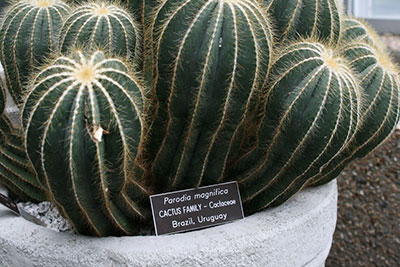Cactus

Parodia magnifica cactus at U.S. Botanic Garden
Cacti are low-maintenance, fun to grow, and well-adapted to the dry conditions found in homes. They come in a range of sizes, colors, shapes, and flowering habit, and grow as upright columns, spreading clumps, or spiny spheres. Some cacti have thorns, so handle with care.
Cacti prefer a sunny location indoors; if you’re growing yours outdoors, be sure to protect them from frost.
They grow slowly, usually only a few inches a year. Never let your cactus stand in water, which leads to root rot. You can leave them in the same container for quite some time, as they generally like to be slightly pot bound.
Repotting Cactus
Cactus should be repotted when their roots show through the holes of the pots, typically every two to four years. The best time is when they start actively growing in spring, often in January or February.
Thick leather gloves are a good idea but may not protect you from stout spines. A smart trick is to use a pair of barbecue tongs to gently lift the plant out of its old pot.
Loosen the roots and inspect them for signs of rot or disease before putting the cactus in its new, slightly larger pot. Fill in around the root ball with a coarse, well-drained potting mix, and be sure to keep the plant at its original depth.
Wait a few days before you water the first time, and then your repotting work is done.
While most cactus plants in Florida are grown in containers, there are a few notable exceptions, including prickly pears and dragon fruit. Prickly pear cactus (Opuntia spp.) grow naturally across the U.S., including six that are native to Florida. Pitaya (Hylocereus), also called dragon fruit, is a epiphytic cactus native to Mexico, Central America, and South America; it has been grown successfully in frost-free areas of the the state. Learn more about dragon fruit in "Pitaya Growing in the Florida Home Landscape."
Also on Gardening Solutions

